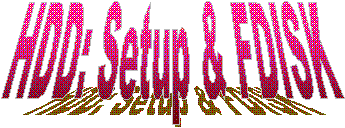

EA-194 PC Systems Support
Resources: HDD’s (preferably
over 1Gigabyte), PC (Large Disk support & IDE support).
Aim: To enable students to competently install, partition and hi-level format a HDD for a PC and to use common tools to manage and maintain a HDD. Students are also expected to gain experience with SCSI devices through interaction during the teacher’s demonstration.
The following tasks are to be performed by students:
Step1 Using the HDD available – set the jumper to configure the HDD as a single master. The jumper pins for this setting are generally labeled "MA".
Step 2 Secure your HDD in the PC cavity allocated for HDD’s (Don’t over tighten screws).
Step 3 Attach the wide ribbon IDE cable to the mainboard’s IDE slot (Ensure that you have positioned the red Striped part of the ribbon where pin #1 is located for the IDE slot and HDD. Pin #1 is generally located on the power supply connector side of the HDD).
Step 4 Secure one of the spare power supply cables to the HDD. This can only fit one way.
Step 5 After rechecking your connections, turn your PC "on" and enter into the CMOS settings (generally accessed by pressing the "Delete" key when prompted at start-up).
Step 6 Using the "arrow" keys navigate to the "HDD autodetect" entry in the main menu and press "enter". Select the HDD type recommended by the auto-detection process (this will probably be the first entry in the list). Press either "Esc" or "No" for each successive HDD auto-detection.
Step 7 Ensure that your PC boot sequence includes the FDD in the CMOS settings. If your HDD is larger than 528 MB make sure the mainboard supports larger HDD’s (i.e. you may have to enable "LBA mode" in the CMOS settings).
Step 8 Now start your PC with your floppy boot disk and run the FDISK.EXE program (you should already have FDISK and FORMAT on your boot disk). If all went well you should be able to display your HDD’s current partition information by selecting the appropriate number from the FDISK menu. Note: If you are asked if you want to enable "Large Disk Support" choose "No".
In this part of the practical you will:
i) Delete the current partitions
ii) Create one "Active" Primary DOS partition that is 50% of total HDD space.
iii) Create an Extended DOS partition equal to the remaining 50% of HDD space.
iv) Create two logical DOS drive partitions within the Extended DOS partition. Each of these will be 50% of the Extended DOS partition in size.
First – Non-DOS partitions.
Second – Any logical DOS drives within the extended partition.
Third – The Extended DOS partition.
Fourth – The Primary DOS partition.
Note: Each time you delete a partition review the changes by using the "Display partition Information [4]" listed in the main menu.
Continue until all partitions have been deleted.
ii) Creating an Active Primary DOS partition: From the initial FDISK menu select "Create DOS partition [1]". You will now be presented with a second menu where you will select "Create a Primary DOS partition [1]". When asked if you would like to use all of the available HDD space for the primary DOS partition – select "No". When asked to enter the amount of space you would like to allocate for the primary DOS partition in Megabytes or percentage of HDD space – enter 50%.
Note: You may now be asked whether you would like to make this partition "ACTIVE". Select "YES", keeping in mind that you are allowed to make a partition "ACTIVE" at any time by selecting it from the list in the main menu.
iii) Creating an Extended DOS partition: Select "Create a DOS partition [1]" from the main menu again and select "Create an Extended DOS partition" from the second menu. Use all of the remaining HDD space left for this partition.
iv) Creating Logical DOS Drives within the Extended DOS partition: Select "Create a DOS partition [1]" from the main menu again and select "Create a logical DOS Drive within the Extended DOS partition" from the second menu. If prompted to use all of the available space in the extended DOS partition, say "No". When prompted to enter the amount of space you would like to allocate for the first logical DOS drive in either Megabytes or a percentage of space – enter 50%. After a moment you will be prompted for the size of your second logical DOS drive – choose the amount shown by pressing the "ENTER" key.
Before exiting FDISK ensure that your partitions are correct by selecting "[4]" to display the partition information again from the main menu.
Now, escape from FDISK and reboot the PC.
Now format all three drives created by FDISK. e.g. a:\> format c: